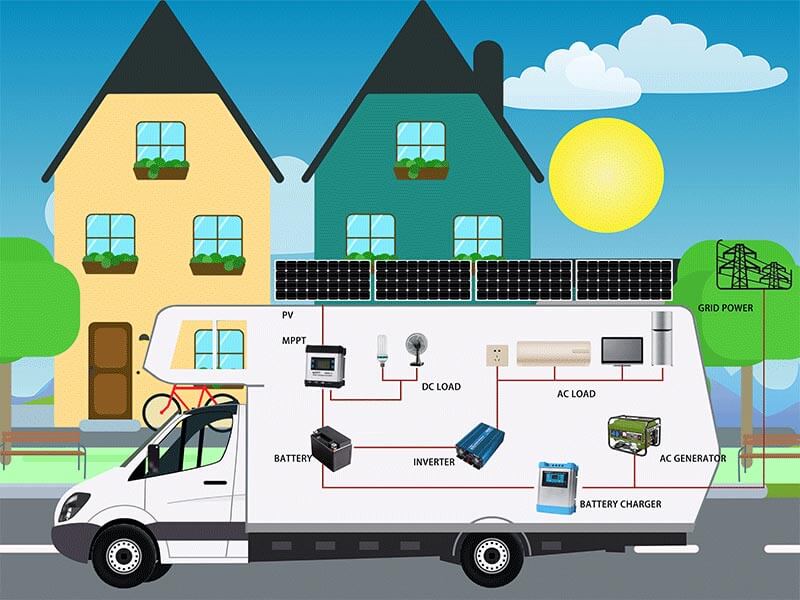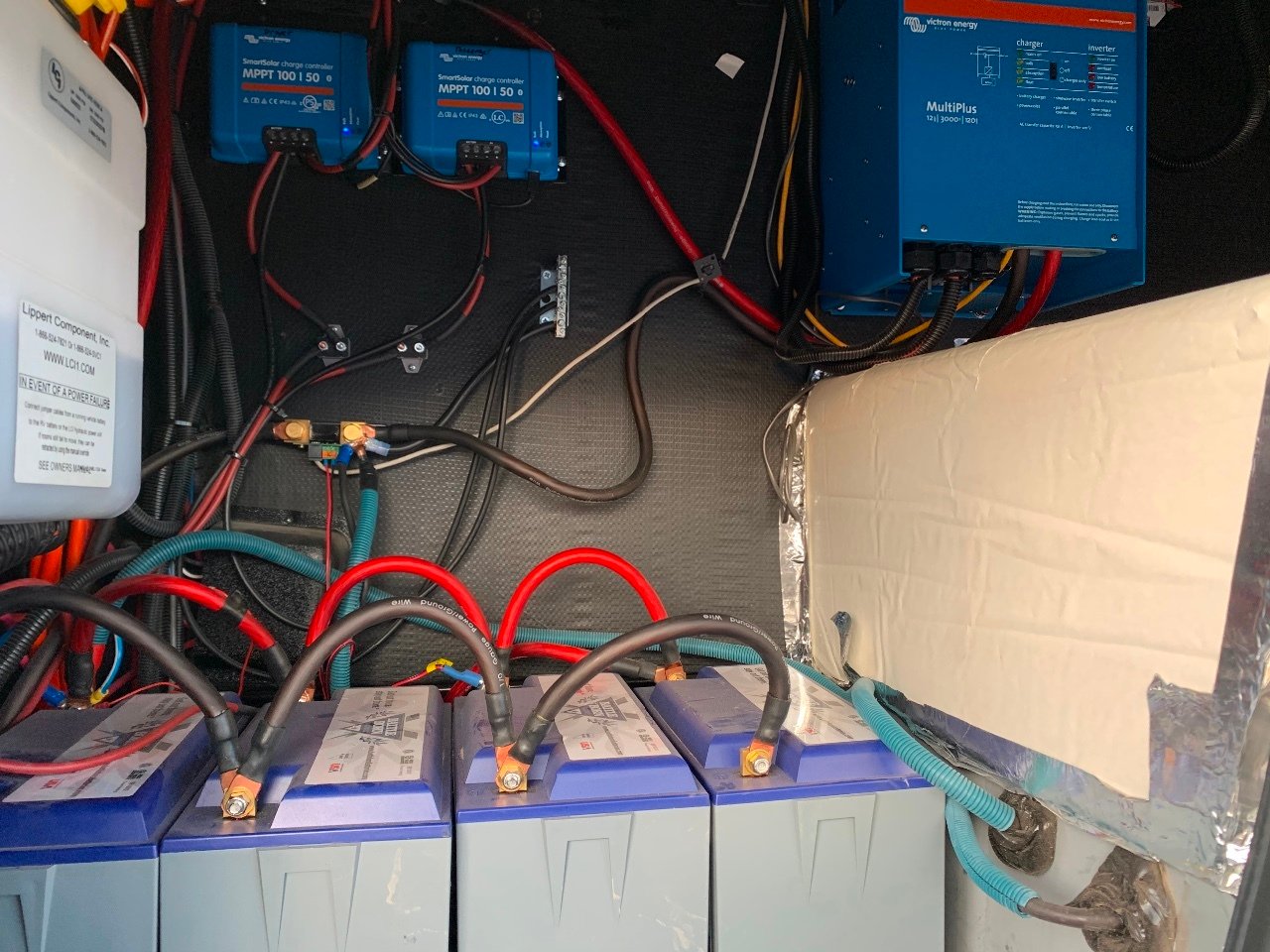Charging an RV battery is essential for maintaining the power supply. Use a dedicated charger or vehicle alternator for efficient charging.
Ensuring your RV battery is adequately charged is crucial for a smooth and enjoyable road adventure. A well-maintained battery enables the use of essential appliances and systems within your recreational vehicle. Regular charging extends the battery’s lifespan and prevents the inconvenience of unexpected power losses.
Understanding the charging process is vital to keeping the journey comfortable and your vehicle’s electrical components functioning optimally. This includes recognizing your RV battery type, choosing the correct charging method, and knowing the appropriate duration. By following these steps, you can secure a reliable source of energy for your RV, guaranteeing peace of mind while exploring the great outdoors.
Introduction To RV Battery Maintenance
Maintaining your RV battery is critical to ensuring a smooth journey. A well-maintained RV battery provides reliable power and extends the battery’s life. Proper care prevents unexpected power issues on the road. Let’s explore the essentials of RV battery maintenance.
Importance Of Reliable Power
Reliable power is crucial for a stress-free RV experience. It runs essential systems like lights, refrigerators, and HVAC. Without power, these comforts become unavailable. Regular battery maintenance keeps everything running.
Lifespan Of Rv Batteries
RV batteries have varying lifespans. Factors like usage, maintenance, and type affect longevity. A battery with proper care may last up to five years, but neglect can significantly shorten this. Follow maintenance tips to extend your battery’s life.
- Check battery charge regularly.
- Clean terminals to prevent corrosion
- Ensure proper storage during off-season
- Use a smart charger to avoid overcharging
Adhering to these tips, your RV battery will power your adventures for years.
Types Of Rv Batteries
Embarking on an RV adventure requires a reliable power source. RV batteries are the heartbeat of your mobile abode. Let’s explore the standard types, each with unique features and benefits.
Lead Acid Batteries
Lead acid batteries are traditional choices for RV use. They come in various designs:
- Flooded: These require regular maintenance, including water top-ups.
- AGM (Absorbent Glass Mat): Sealed, maintenance-free, and resists vibration.
- Gel: These also require no upkeep and offer deep discharge recovery.
Despite being cost-effective, lead acid batteries are heavier and have a shorter lifespan than other types.
Lithium-ion Options
Lithium-ion batteries represent the latest in RV power storage. Their benefits include:
| Feature | Benefit |
|---|---|
| Lightweight | Easier to handle and reduces overall RV weight. |
| Long Lifespan | It lasts longer than lead acid, reducing replacement costs. |
| Efficiency | Provides consistent power and charges faster. |
| Maintenance-free | Zero upkeep is needed, saving time and effort. |
Though the upfront cost is higher, the long-term gains in durability and performance make lithium-ion an intelligent investment for serious RV enthusiasts.
Initial Battery Charging Process
Embarking on an RV adventure starts with a crucial step: charging the battery. A fully charged and well-maintained battery ensures a smooth journey. Let’s dive into the initial charging process.
Setting Up For First Use
Before hitting the road, setting up your RV battery properly is essential. Follow these steps:
- Inspect the battery: Check for damages or leaks.
- Clean terminals: Ensure they are free of corrosion.
- Install the battery: Secure it in the designated spot.
- Connect cables: Attach the positive cable first, then the negative.
- Check voltage: Ensure the battery reads above 12.6 volts.
Charging Recommendations
For optimal performance, follow these charging tips:
- Use the proper charger: Match the charger to your battery type.
- Charge slowly: Opt for a slow, steady charge over a quick boost.
- Avoid overcharging: Prevent damage by monitoring the charge.
- Maintain charge levels: Keep the battery above 50% to prolong life.
Remember, regular maintenance after the initial charge is critical to battery longevity.
Regular Charging Techniques
Keeping your RV battery charged is essential for a smooth journey. Explore the most common methods to ensure your battery remains powered up and ready to go.
Solar Charging Solutions
Solar energy can generate an environmentally friendly charge. Solar panels convert sunlight into electricity, keeping batteries full without a plug.
- Portable Solar Kits: Easy to set up and move around.
- Fixed Solar Panels: Install on your RV roof for continuous charging.
- Solar Charge Controllers: Protect batteries from overcharging.
Choose a kit that matches your power needs. Check the wattage and battery compatibility.
Shore Power Charging
Connect to an external power source with shore power. It’s a reliable way to charge when the sun sets or on cloudy days.
- Find a campground with electrical hookups.
- Use the right adapter for a secure connection.
- Monitor the charging process to prevent overcharging.
Ensure the RV’s electrical system matches the campground’s power output. Use a surge protector for safety.
Optimizing Charge Cycles
RV enthusiasts know the heart of their adventure mobile is the battery. Optimizing charge cycles is key to long-lasting power. Proper charging extends battery life and ensures readiness for the road.
Understanding Depth Of Discharge
Depth of Discharge (DoD) measures how much battery power you use. A lower DoD equals a longer battery life. Aim to keep the DoD under 50% to maximize cycle life. Lead-acid batteries need more care, while lithium batteries handle deeper discharges better.
- Lead-acid: Keep DoD < 50%
- Lithium: More tolerant to deep discharges
Charge Controllers And Maintainers
Charge controllers protect your RV battery, preventing overcharging and deep discharge. Maintainers keep batteries at full charge during storage, avoiding damage and preparing for spontaneous trips.
| Type | Function |
|---|---|
| Charge Controller | Regulates voltage and current |
| Maintainer | Keeps battery fully charged |
Troubleshooting Common Issues
Keeping an RV battery in top shape requires some know-how. Even with the best care, issues can arise. Let’s tackle some common problems and restore your RV battery.
Overcharging And Its Effects
Battery overcharging can shorten the battery’s life. RV batteries are meant to handle specific charge levels. Too much charge leads to excessive heat and fluid evaporation inside the battery, which can cause permanent damage.
- Check the charger: Ensure it matches the battery type.
- Monitor voltage: Use a multimeter to avoid high voltage.
- Use an intelligent charger: These stop charging when the battery is full.
Dealing With Deep Discharge
A deep discharge happens when a battery drains completely. This can harm its ability to hold a charge. Here’s how to deal with this issue:
| Step | Action |
|---|---|
| 1 | Recharge slowly: Use a low amp setting on your charger. |
| 2 | Check connections: Ensure they are clean and tight. |
| 3 | Test the battery: After charging, test with a multimeter. |
Remember to charge regularly to prevent deep discharge. Track usage and recharge as needed to maintain battery health.
Winterizing Your RV Battery
As temperatures drop, preparing your RV battery for winter is crucial. This guide covers the essentials of winterizing your RV battery. Follow these tips to ensure your battery remains healthy and ready for the next adventure.
Proper Storage Techniques
Choosing the right storage location is critical for your RV battery’s longevity. Store your battery in a cool, dry place away from harsh temperatures. A garage or basement works well. Keep the battery off the ground on wood or a shelf. This prevents cold floors from draining the charge.
Maintaining Charge In Cold Weather
Batteries lose charge faster in cold weather. Use a quality battery maintainer to keep your RV battery topped up. This device ensures a full charge without overcharging. Check the battery level monthly. This simple step can extend your battery’s life through the winter months.
- Disconnect the battery before storage.
- Store in a temperature-controlled environment.
- Use a wood block or shelf for storage.
- Check charge level regularly.
- Use a battery maintainer to keep it charged.

Credit: www.youtube.com
Advanced Tips And Tricks
Charging an RV battery goes beyond plugging in and waiting for a full charge. It involves techniques to ensure longevity and efficiency. Advanced tips can optimize the process. Let’s dive into these advanced strategies.
Balancing Battery Banks
Battery banks need balance for peak performance. Here’s how to maintain it:
- Check individual battery voltages: Use a multimeter to ensure they match.
- Equalize charges regularly: This process rebalances battery cells.
- Rotate batteries: Change their positions to promote even wear.
- Monitor often: Catch imbalances before they affect performance.
Upgrading Your Rv Power System
Upgrades can boost your system’s capacity. Consider these:
| Upgrade | Benefits |
|---|---|
| Solar Panels | Provides clean, free energy. |
| Lithium Batteries | Longer life, faster charging. |
| Inverter Charger | Charges batteries and converts power. |
| Smart Chargers | Adjusts to battery needs and prevents overcharging. |
Remember, professional installation ensures safety and maximizes benefits.
Safety Precautions During Charging
Charging an RV battery is crucial for a great trip. Yet safety comes first. With the right steps, we can ensure a secure charging process.
Personal Protective Equipment
Before charging, gear up for safety. Wear the essentials:
- Gloves: Non-conductive material is best.
- Goggles: Protect your eyes from splashes.
- Apron: A rubber apron guards your clothes.
These items shield you from electric shocks and spills.
Handling Battery Acid And Fumes
Battery acid is dangerous. Handle it with care:
- Ventilation: Charge in a well-aired area.
- Neutralize Spills: Use baking soda for acid spills.
- No Flames: Keep sparks and fire away from batteries.
Remember to stay calm and react quickly if acid touches your skin. Rinse it off immediately with water.

Credit: www.carspa.cc

Credit: aolithium.com
Frequently Asked Questions
How Do You Charge Your RV Battery?
Charge your RV battery by connecting it to a shore power source, using a generator, or installing solar panels. To maintain battery health, ensure proper charging with a smart charger. If necessary, regularly check and maintain the battery’s water level.
Can I Charge My Rv Battery While It Is Connected?
Yes, you can charge your RV battery while it’s connected, but ensure all devices are off and follow the manufacturer’s safety guidelines.
Do I Need To Trickle Charge My RV Battery?
Yes, trickle charging your RV battery maintains its charge and prolongs its life, especially during prolonged storage periods. Use a proper trickle charger to ensure safe charging.
Should You Leave Your RV Plugged In All The Time?
It is not recommended to leave your RV constantly plugged in. This can overcharge and degrade the battery, increasing replacement costs. To extend the battery’s life, regularly check and maintain it. Use a timer to manage charging periods, ensuring optimal battery health.
Conclusion
Keeping your RV battery charged ensures readiness for adventure. Adopting the correct charging methods prolongs battery life and enhances performance. Remember, regular maintenance and intelligent charging habits are essential. So, hit the road confidently, knowing your RV’s power source is in top condition and ready for wherever the journey takes you.

